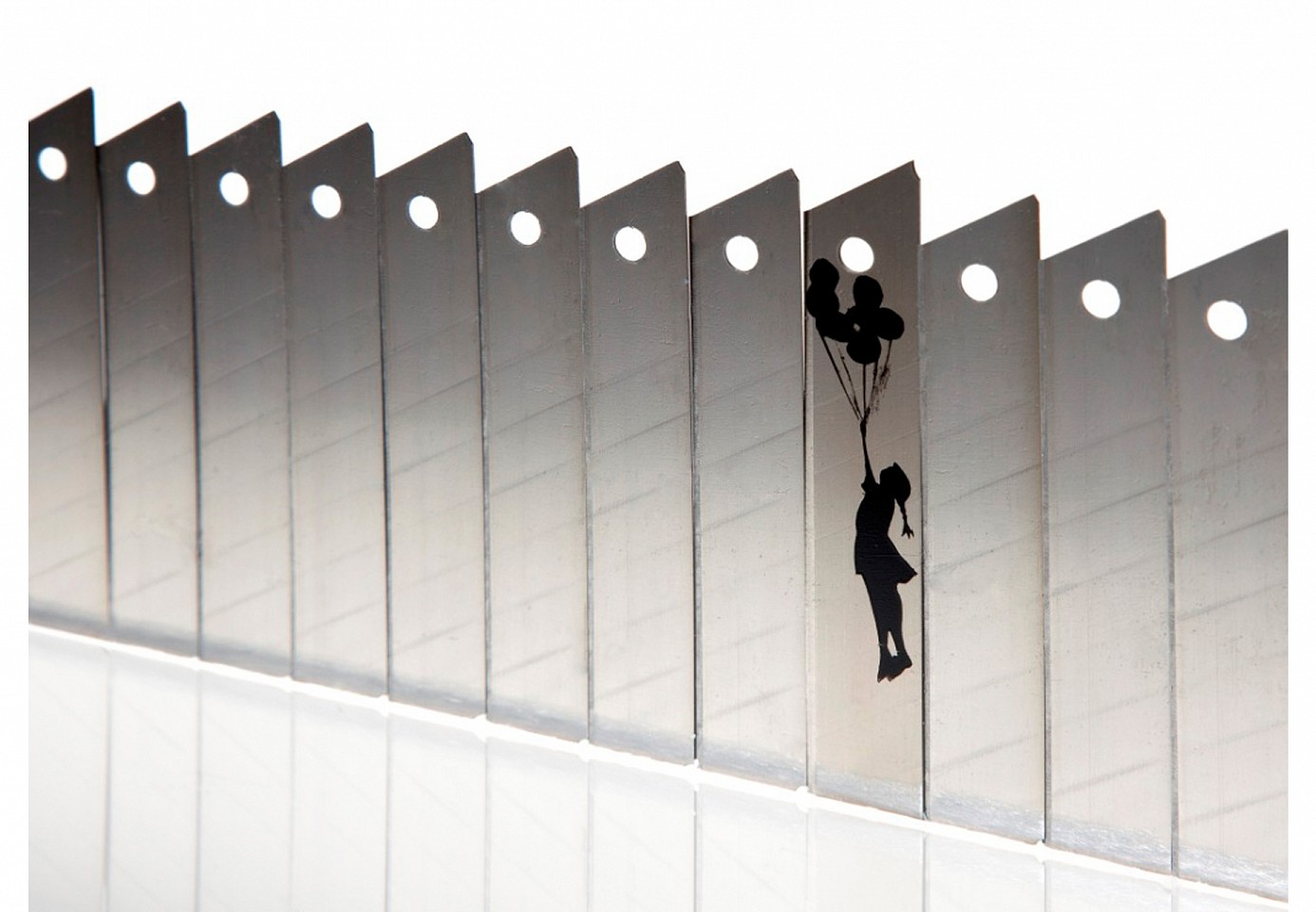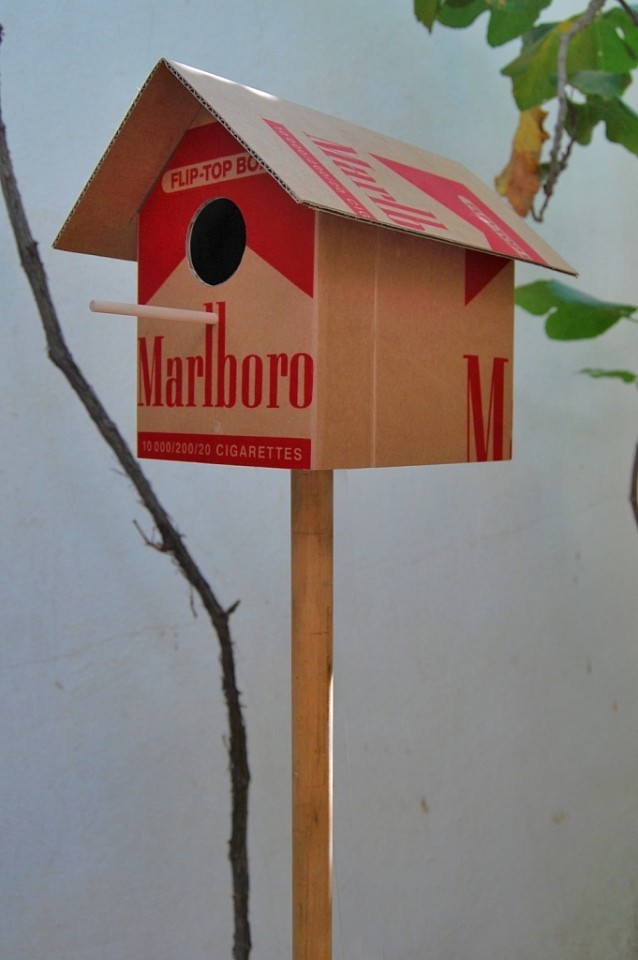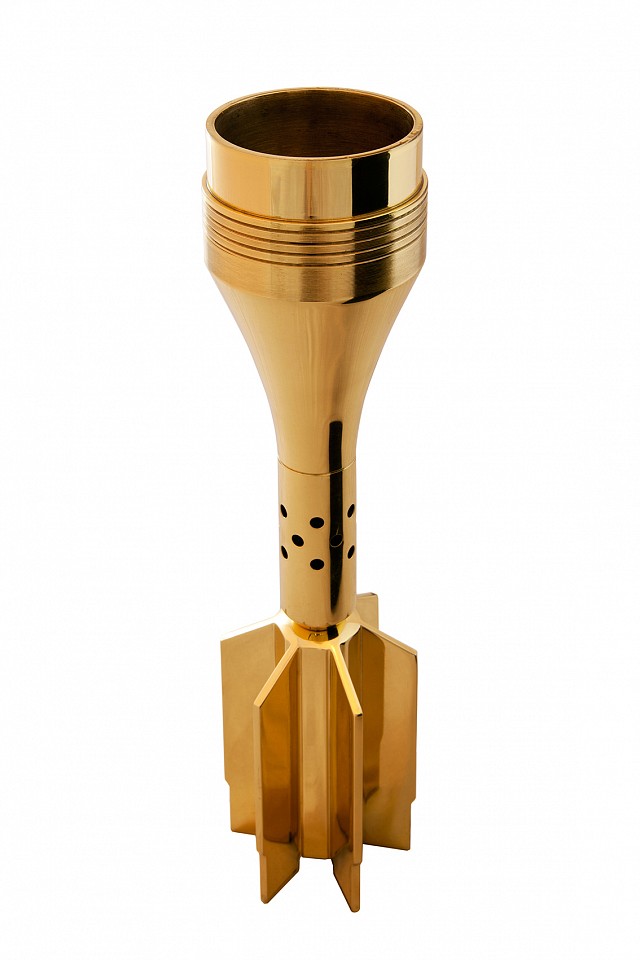Ibrahim Abumsmar
Cutting Edge, 2012
Metal Blades on Corian
15 x 133.5 cm x 15 cm (blade: 5 cm)
Edition of 3 + 1AP, Acquired by Castello di Rivoli Museum of Contemporary Art, Italy
IAM0016
Ibrahim Abumsmar
The BirdHouse, 2012
Cardboard & Wood
5 Pieces Bird House: 22 x 28 x 15 cm, 30 x 30 x 158 cm, 30 x 30 x 184 cm, 30 x 30 x 207 cm, 30 x 30 x 259 cm, 30 x 30 x 233 cm
Variation of 6 + 1AP
IAM0017
Ibrahim Abumsmar
Al Mabkhara, 2010
Copper
33 x 7.5 cm (13 x 3 in.)
Edition of 5 + 2 AP, Acquired by Salsali Private Museum
IAM0011



This work is comprised of 67 cutting blades, lined up side by side to form a uniform grey wall. Stenciled on the blades is Banksy’s iconic image of a little girl floating above the wall and being carried across by balloons. This unmistakably identifies the work as a reconstruction of the West Bank Wall in Palestine. The artist’s particular use of cutting blades is a loud indication of the artist’s feelings about the wall’s destructive, dissecting and dangerous purpose. The number 67, as per the artist’s research, is the exact number of villages and farms that the wall obliterated.
Although many Palestinians artists have explored the subject of the wall, Being a Saudi artist, Abumsmar’s work demonstrates that while many Arab governments have quieted towards the plight of the Palestinians, the solidarity that the Arab people feel with their Palestinian brothers remains strong.
Birds' lives on trees, they build their nests on the twigs and live there in peace, playing their role in the nature, milllions of trees around the globe are playing their role in nature, keeping the balance in the proportion of gases to keep the enviornment good enough to live in, we should share share the nature with all the other creatures, instead of this... We cut down trees to make wood, paper and other materials and we build stylish houses for birds, they are comfortable, good looking and colorful,for us.
But there's one question: Did the birds ask us to do?
Incense, being an article familiar to humanity since the dawn of civilization, has meant different things to different peoples who havecome to use it. Given the wide diversity of such peoples and their practices, it would be impossible to form an all-inclusive list of the ways in which incense has come to be sued, since the methods and purposes of employment are as divers and nuanced ad those who have employed it.
Its something common between most of the religions on earth, religions also were one of the main causes of most of the wars in history were battled.
In the present time we use extremely lethal weapons to use in war one of there weapons is the mortar. I found a funny stimulation between the shape of the mortar shell after it launched and a type ofthe ancient censer. I wonder if we could replace the killing gunpowder with an aromatic incense to spread peace and love between humans!
Torin, Italy: This is a momentous occasion for Athr Gallery at it is the first time that a Saudi contemporary art gallery participates in a Western art fair.
Athr represents primarily Saudi artists, but have also begun representing promising artists from neighbouring regions, such as Hazem Harb, who is an established Palestinian artist. The works selected for Athr Gallery's booth express a dialogue between Saudi Arabia and the wider Middle Eastern region, exploring themes of violence, politics, spirituality and digital connectivity, within the present context of the Arab Spring. Two artists, Hazem Harb and Ibrahim Abumsmar's works converse with each other very nicely- as a Saudi and a Palestinian artist that both explore the same subject and try give the viewer a better understanding of the war they have lived through. There will be range of mediums displayed from sculpture to mixed media and photography.
During Artissima 2012, Athr Gallery will feature the work of the following artists:
Born in 1966, Ayman Yossri has lived almost all his life in Jeddah and identifies with Saudi Arabia but is in fact of Palestinian origin. This sense of national dislocation has an effect on his artistic production. The exhibited Subtitles work all address the theme of political power, a subject that is now more than ever relevant to the Middle East region that for the past two years has been undergoing the revolutionary turmoil of the Arab Spring. A number of the works however (In Aradta Al-Salam), created in 2009, precede the Arab Spring, and can be considered prophetic in their expression of the artist’s unease about the increasingly volatile situation and the involvement of foreign powers in the region. Over the past two years, as the domino effect of revolution has almost systematically taken over Arab countries such as Tunisia, Egypt, Libya and currently Syria, Ayman Yossri Daydban has continued to explore this theme via his Subtitle series. Ihramaat is a concept born out of a defining tradition and custom adopted during the holy Hajj pilgrimage. Daydban uses authentic Ihramat, the customary white cloth worn by pilgrims to Makkah, stretched onto wooden frames and presents them in multiple variations. Traditionally, every man performing his pilgrimage is required to wear white cloth. It erases any distinguishing features between himself and his neighbor and presents them as one, stripped down to their purest form, all equal and united under the same faithful brotherhood.
Born in 1980 in Gaza City, Palestinian artist Hazem Harb deals with a number of core themes including war, loss, trauma, human vulnerability and global instability. He continues to explore his own brand of multi-media, conceptual art using all the tools at his disposal. In Beyond Memories he encompasses the geographical, social and familial history of Palestinians, both before and after 1948. The original image takes us back in time and memory. But he then digitally transformed the image so that it is different than the original, and does not reflect the original time, for the political and social changes to the lives of Palestinians that occurred during the 40’s have completely changed the impressions of the image’s subject. The memory of the place no longer has any strength of narrative, for the place is no longer as it was. Its features have morphed as a result of geographic division and the demolition of a civilization that spanned thousands of years.
Ibrahim Abumsmar was born in Saudi Arabia in 1976. He recreates everyday objects as sculptures, with the intention of questioning the essence of their identity. The Birdhouse challenges this perceived practicality and suggest that the objective of their creation is more symbolic than practical. Birds live in trees, where they build their nests on branches and carry out their lives in peace. Instead of playing our role in maintaining the balance, we cut down trees to make wood, paper, and ironically birdhouses. They create the illusion that we are helping the environment, but in fact, they merely satisfy our own selfish decorative inclinations, which we hide behind the cloak of environmentalism. In Al Mabkhara the artist exaggerates the similar shapes of the incense burner and the mortar shell – a lethal weapon used in modern warfare. The result is the creation of a new and unique object, the purpose of which is to symbolically replace gunpowder with aromatic incense to spread peace and love amongst mankind. Cutting Edge is comprised of 67 cutting blades, lined up side by side to form a uniform grey wall. Stencilled on the blades is Banksy’s iconic image of a little girl floating above the wall and being carried across by balloons. This unmistakably identifies the work as a reconstruction of the West Bank Wall in Palestine. The artist’s particular use of cutting blades is a loud indication of the artist’s feelings about the wall’s destructive, dissecting and dangerous purpose. The number 67, as per the artist’s research, is the exact number of villages and farms that the wall obliterated. Although many Palestinians artists have explored the subject of the wall, being a Saudi artist, Abumsmar’s work demonstrates that while many Arab governments have quieted towards the plight of the Palestinians, the solidarity that the Arab people feel with their Palestinian brothers remains strong.
Jowhara Al Saud was born in Saudi Arabia in 1978 and now splits her time between New York and Jeddah, Saudi Arabia. Her work is part of the collection of the Victoria & Albert Museum, London, The Greenbox Museum, Amsterdam, as well as many private collections across Europe, the US and the Middle East. Her Knots series are works that are still, and will most likely remain, incomplete. Inspired by traditional Mashrabiya, tooled wooden screens traditionally separating the private and public spaces in Islamic Architecture, they are about many things. They revel in the ‘in between’; photography and drawing, public and private space, representation and abstraction, obscuring and revealing. Whether they transcend or trespass, these are about the lines we draw, and the spaces in between.
Sami Al Turki was born in 1984, of Saudi nationality. His impressions of his home country, Saudi Arabia, and his current city where he is living, Dubai, are the driving force behind his concepts and visions. Turki’s eclectic and varied style is a reflection of both his diverse cultural upbringing and the confused occidental vs. oriental atmosphere of Dubai. In Nets the grid like - honeycomb structure of social networks, which are fiercely taking over the mindset of the global population on the issues of connectivity, are corporatizing the human entity from a living breathing person to a dossier on a virtual grid space; somehow the future looks like something from the Tyrrell co from the cult fiction Blade runner. The clients or users of these networks or web nets are abruptly becoming more dependent on these environments, adopting isolation at the price of being individual, making the virtual a basis for almost all relationships with others.






